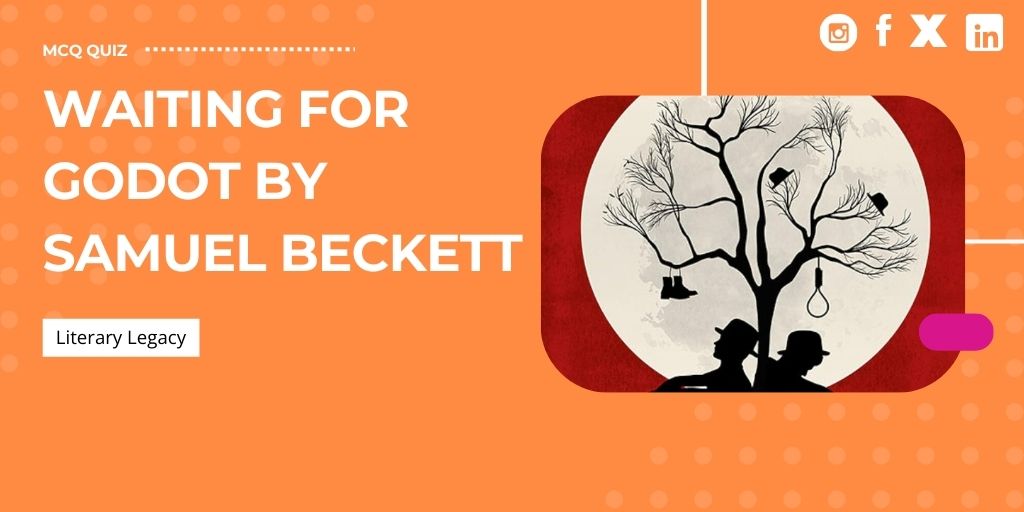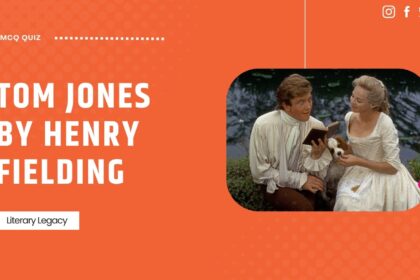1. What leads Lucky to try to impress Pozzo?
Choices
A) He has a loyalty to Vladimir.
B) He wants to win over Estragon.
C) He is afraid of being sold.
D) He wants to gain his freedom.
Answer: (C)
He is afraid of being sold.
Lucky is trying to impress Pozzo to avoid being sold, as Pozzo has multiple slaves.
2. What is Pozzo’s emotional state during his interaction with Estragon and Vladimir?
Choices
A) He is indifferent to their presence.
B) He becomes emotional and cries.
C) He seems overly joyful and carefree.
D) He is mocking them continuously.
Answer: (B)
He becomes emotional and cries.
Pozzo becomes emotional, even crying when Lucky kicks him.
3. During the second act, what significant change occurs with Pozzo?
Choices
A) He gains his sight.
B) He develops a strong friendship with Estragon.
C) He becomes wealthy and powerful.
D) He loses his vision.
Answer: (D)
He loses his vision.
Pozzo becomes blind in the second act, representing a shift in his character.
4. What does Estragon want to do with his belt at one point in the play?
Choices
A) Use it to fashion a tool.
B) Hang himself from a tree.
C) Replace Lucky’s rope.
D) Give it as a gift to Vladimir.
Answer: (B)
Hang himself from a tree.
Estragon suggests they hang themselves with his belt to escape their situation.
5. What does the boy who brings a message from Godot say?
Choices
A) Godot is not real.
B) Godot has forgotten about them.
C) Godot will arrive tomorrow.
D) Godot is sick and will not come.
Answer: (C)
Godot will arrive tomorrow.
The boy delivers the message that Godot will not come today but will come tomorrow.
6. What do Estragon and Vladimir do with Lucky’s hat?
Choices
A) They trade it back and forth.
B) They throw it away in frustration.
C) They bury it as a sign of respect.
D) They use it as a tool for communication.
Answer: (A)
They trade it back and forth.
Vladimir and Estragon trade Lucky’s hat back and forth, trying on different hats.
7. What common theme does the play ‘Waiting for Godot’ primarily focus on?
Choices
A) Love and companionship.
B) The quest for wealth and power.
C) Waiting and boredom.
D) The pursuit of knowledge.
Answer: (C)
Waiting and boredom.
The central act of the play revolves around waiting, highlighting themes of boredom and nihilism.
8. How do Vladimir and Estragon respond at the end of the play regarding their decision to leave?
Choices
A) They leave without looking back.
B) They sit in silence and do not move.
C) They run in fear of Pozzo.
D) They argue about where to go next.
Answer: (B)
They sit in silence and do not move.
The play ends with Vladimir and Estragon saying they will leave, but neither takes action to do so.
9. What does Pozzo offer in exchange for help when he falls?
Choices
A) His hat.
B) Money.
C) Food and drink.
D) A promise of friendship.
Answer: (B)
Money.
Pozzo cries for help and offers money as a reward for assistance in getting up.
10. What does Vladimir suggest they should do to fill the silence when they struggle to talk?
Choices
A) Recall memories of the past.
B) Engage in a game.
C) Start singing a song.
D) Discuss their dreams.
Answer: (B)
Engage in a game.
Vladimir suggests they play at being Pozzo and Lucky to fill the silence.
11. What theme connects the characters’ continuous waiting and their feelings of being ‘bored to death’?
Choices
A) Surrealism
B) Nihilism
C) Existentialism
D) Romanticism
Answer: (B)
Nihilism
Nihilism reflects the characters’ feelings of hopelessness and the absurdity of their waiting.
← Help us improve by rating questions!
12. Which literary movement does Waiting for Godot primarily connect with due to its innovation and break from the past?
Choices
A) Romanticism
B) Postmodernism
C) Naturalism
D) Baroque
Answer: (B)
Postmodernism
Beckett’s play belongs to both Modernism and Postmodernism, emphasizing innovation in literature.
13. How is the concept of time characterized in Waiting for Godot?
Choices
A) It is linear and predictable.
B) It is uncertain and ambiguous.
C) It is clearly defined and structured.
D) It is cyclical and repetitive.
Answer: (B)
It is uncertain and ambiguous.
The play’s time setting is vague, creating an air of uncertainty for both characters and audience.
14. What is one reason Estragon struggles in the beginning of the play?
Choices
A) He cannot remember why they are waiting.
B) He is craving food and unable to find any.
C) He is afraid of an encounter with Godot.
D) He struggles to take off his boots.
Answer: (D)
He struggles to take off his boots.
Estragon’s difficulty with his boots symbolizes his helplessness and despair.
15. The character Godot is significant in the play because he symbolizes what?
Choices
A) Fear of the unknown.
B) Temporal existence.
C) Hope and salvation.
D) Historical progress.
Answer: (C)
Hope and salvation.
Godot symbolizes the hope for something better that always seems to be just out of reach.
16. What is the nature of the relationship between Pozzo and Lucky?
Choices
A) Pozzo supports Lucky as a mentor.
B) Lucky is Pozzo’s slave, treated poorly.
C) They are equal companions.
D) They are brothers who have had a falling out.
Answer: (B)
Lucky is Pozzo’s slave, treated poorly.
Lucky is subjected to abuse and represents a dynamic of power imbalance in their relationship.
17. Which of the following describes a key characteristic of the setting in Waiting for Godot?
Choices
A) A futuristic landscape.
B) A well-defined historical context.
C) A bustling city environment.
D) An unspecified time along a road.
Answer: (D)
An unspecified time along a road.
The play is set on the side of an unidentified road, emphasizing its timelessness and existential themes.
18. What does the lack of a true climax in the play suggest about its overall theme?
Choices
A) The absurdity of existence.
B) The inevitability of conflict.
C) The clear progression of time.
D) The importance of emotional resolution.
Answer: (A)
The absurdity of existence.
The absence of a climax highlights the absurd nature of waiting and the struggles of the characters.
19. What prop is given exaggerated significance in Waiting for Godot?
Choices
A) Rope
B) Food
C) Boots
D) Hats
Answer: (D)
Hats
The hats worn by the characters symbolize their identities and the absurdity of their situations.
20. What does the name ‘Godot’ evoke for many readers in the play?
Choices
A) A representation of hope.
B) A sense of adventure.
C) A reflection of fear.
D) A resemblance to God.
Answer: (D)
A resemblance to God.
The name ‘Godot’ suggests a connection to God, underscoring the play’s existential themes.
21. What is Estragon struggling to remove at the beginning of the scene?
Choices
A) One of his boots
B) His glove
C) His coat
D) His hat
Answer: (A)
One of his boots
Estragon’s struggle with his boot symbolizes his discomfort and the absurdity of their waiting.
22. What does Vladimir tell Estragon about the thieves crucified alongside Jesus?
Choices
A) Both thieves were saved.
B) Only Jesus was crucified.
C) One thief was saved, but there is doubt about it.
D) Neither thief was saved.
Answer: (C)
One thief was saved, but there is doubt about it.
Vladimir’s uncertainty about the story reflects the play’s themes of doubt and belief.
23. What does Estragon suggest they do while waiting for Godot?
Choices
A) Go for a walk
B) Take a nap
C) Sing a song
D) Hang themselves on the tree
Answer: (D)
Hang themselves on the tree
The suggestion to hang themselves highlights their despair and the absurdity of their situation.
24. How does Vladimir react when Estragon begins to describe his dream?
Choices
A) He encourages him to continue.
B) He laughs at the dream.
C) He changes the subject.
D) He angrily stops him.
Answer: (D)
He angrily stops him.
Vladimir’s reaction reflects his discomfort with the bleakness of their reality, as described in Estragon’s dream.
25. What does Pozzo use to control Lucky when they first enter?
Choices
A) A chain
B) A leash
C) A stick
D) A whip
Answer: (D)
A whip
Pozzo’s treatment of Lucky exemplifies the themes of power dynamics and dependency in the play.
26. What do Estragon and Vladimir ultimately decide to do while they wait for Godot?
Choices
A) Help Pozzo with Lucky
B) Continue waiting
C) Practice their speeches
D) Leave the area
Answer: (B)
Continue waiting
Their decision to continue waiting emphasizes the play’s exploration of time and expectation.
27. What does Estragon beg Pozzo for when he arrives?
Choices
A) A cigarette
B) Leftover bones
C) Water
D) Chicken
Answer: (B)
Leftover bones
Estragon’s desperation for leftover bones underlines the theme of deprivation in the play.
28. Why does Vladimir express outrage towards Pozzo’s treatment of Lucky?
Choices
A) He believes Lucky deserves freedom.
B) He desires Pozzo’s leftovers.
C) He wants to assert dominance.
D) He feels sorry for Lucky.
Answer: (D)
He feels sorry for Lucky.
Vladimir’s outrage indicates a moral stance against the cruelty of Pozzo’s treatment of Lucky.
29. What item does Vladimir ultimately find to give to Estragon?
Choices
A) An apple
B) A carrot
C) A potato
D) A piece of bread
Answer: (B)
A carrot
The carrot serves as a symbol of sustenance and caring amid their existential struggles.
30. How does Pozzo explain Lucky’s unwillingness to put down his bags?
Choices
A) Lucky thinks it is his right.
B) Lucky is lazy.
C) Lucky fears being punished.
D) Lucky enjoys carrying them.
Answer: (A)
Lucky thinks it is his right.
Pozzo’s justification reflects the absurdity and complexity of their relationship, highlighting themes of duty and subservience.
31. Why does Lucky cry during the interaction with Pozzo?
Choices
A) He feels neglected by Pozzo.
B) He is tired of being a slave.
C) He wants to entertain Estragon and Vladimir.
D) He is scared of being sold.
Answer: (D)
He is scared of being sold.
Lucky cries because he fears being sold by Pozzo, which highlights the precarious nature of his existence.
32. What does Pozzo lose during the first act?
Choices
A) His hat
B) His pipe
C) His sense of time
D) His memory
Answer: (B)
His pipe
Pozzo misplaces his pipe, reflecting his chaotic state and leading to his philosophical musings.
33. How does Estragon respond when he first recalls his interaction with Pozzo and Lucky?
Choices
A) He is frustrated at not remembering.
B) He excitedly remembers everything.
C) He recalls his beating by Pozzo.
D) He insists that nothing happened.
Answer: (D)
He insists that nothing happened.
Estragon dismisses the importance of his previous encounters, illustrating the theme of forgetfulness.
34. What does the boy who brings a message from Godot say about Godot’s nature?
Choices
A) He is angry with Vladimir.
B) He does nothing.
C) He is always busy.
D) He is an evil master.
Answer: (B)
He does nothing.
The boy’s comment that Godot does nothing emphasizes the absurdity of waiting for a figure who symbolizes inaction.
35. What action do Estragon and Vladimir consider when they want to leave?
Choices
A) Hanging themselves from a tree.
B) Calling for Godot.
C) Taking Lucky with them.
D) Running away together.
Answer: (A)
Hanging themselves from a tree.
The suggestion to hang themselves reflects their deep existential despair and the absurdity of their situation.
36. What does Pozzo’s blindness symbolize during the second act?
Choices
A) His inability to control Lucky.
B) The confusion of identity.
C) The passage of time.
D) His loss of power.
Answer: (D)
His loss of power.
Pozzo’s blindness symbolizes a reversal of power dynamics between him and Lucky.
37. What is the main activity that Estragon and Vladimir engage in throughout the play?
Choices
A) Waiting for Godot.
B) Fighting with Pozzo.
C) Constructing something.
D) Traveling to different locations.
Answer: (A)
Waiting for Godot.
The act of waiting is central to the play, highlighting themes of time and existential futility.
38. What humorous yet tragic action do Estragon and Vladimir perform related to Pozzo and Lucky?
Choices
A) They complain about them.
B) They offer them food.
C) They beat them up.
D) They try to imitate them.
Answer: (D)
They try to imitate them.
Estragon and Vladimir pretend to be Pozzo and Lucky, which illustrates the absurdity and humor intertwined in their existence.
39. What do Vladimir and Estragon struggle with when they seek to fill the silence?
Choices
A) Remembering past events.
B) Creating a story.
C) Discussing philosophical ideas.
D) Finding meaningful dialogue.
Answer: (D)
Finding meaningful dialogue.
Their difficulty in finding meaningful conversation reflects the absurdity and emptiness of their waiting.
40. What happens when Estragon tests the strength of his belt?
Choices
A) He successfully hangs himself.
B) It becomes tighter.
C) He injures himself.
D) It breaks.
Answer: (D)
It breaks.
The belt breaking is a metaphor for the futility and fragility of their attempts to escape their circumstances.



